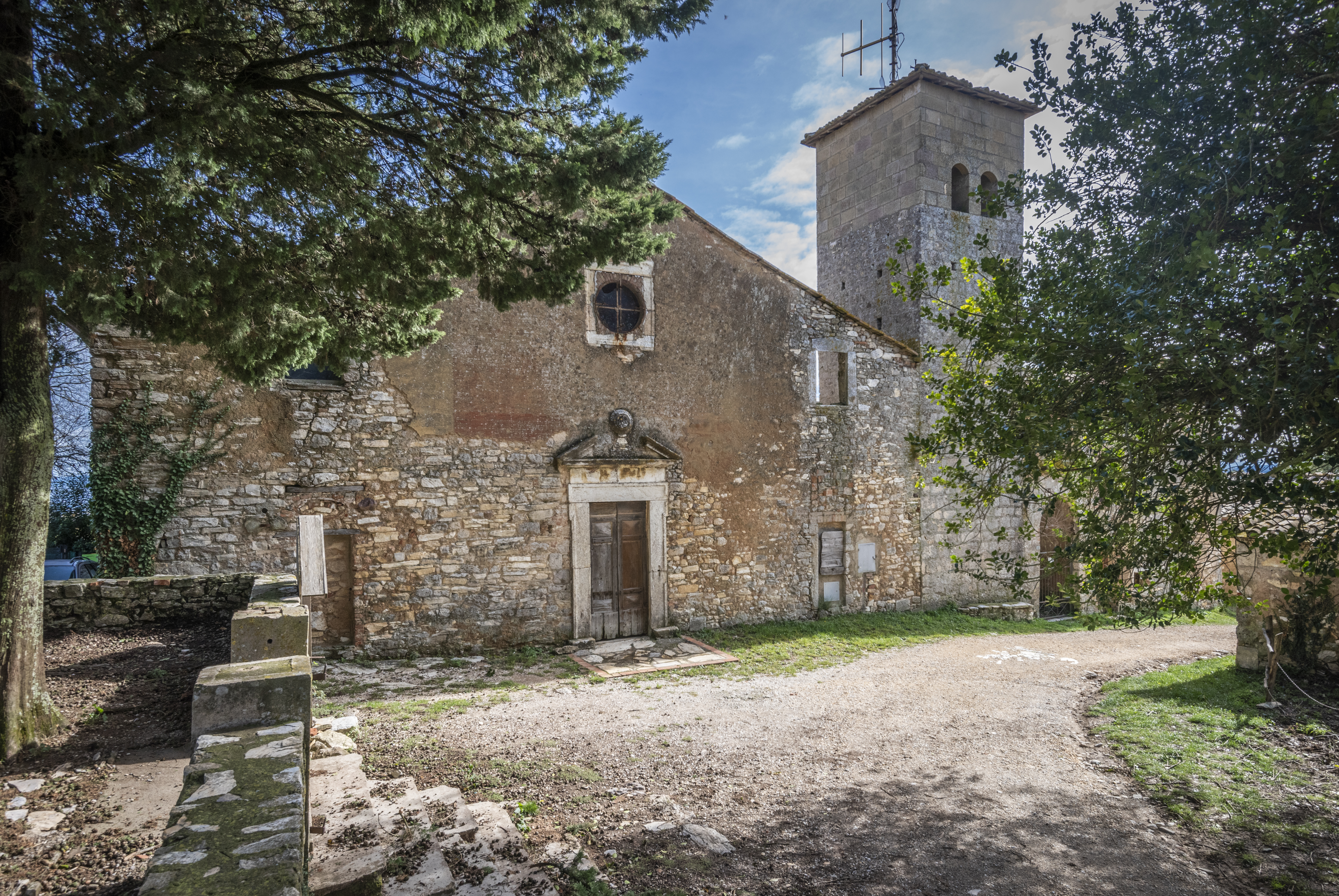1.4 Sovicille and its spiritual parishes
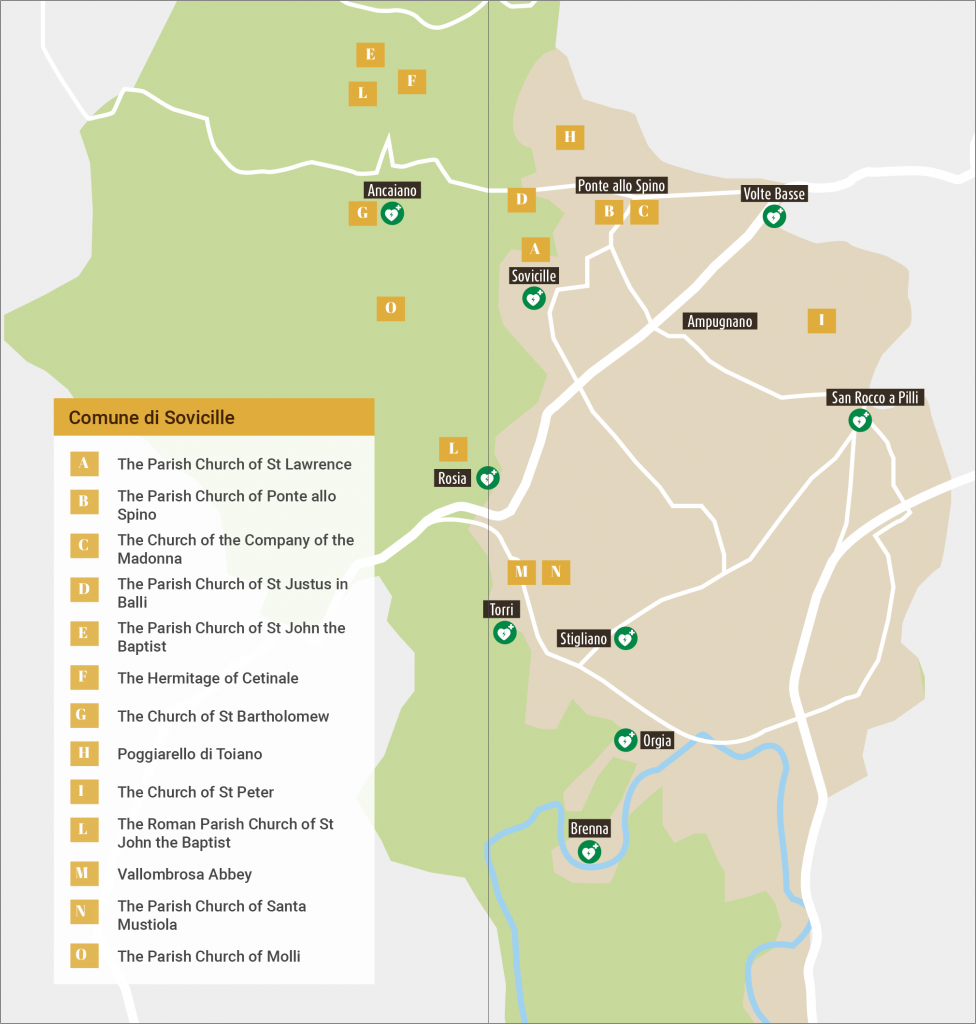
Churches, parishes, and abbeys. The land of Sovicille offers many clues for those who wish to go in search of legends and buildings that are imbued with a sense of history. After all, Sovicille is one of the richest of Tuscany’s fiftyfive medieval villages. The flat landscape makes it suitable for excursions for the whole family by car, on foot, or by bike. Let us start with its capital, Sovicille, where we find the Parish Church of St Lawrence in Piazza Marconi, right in the heart of the historic town. This church was named after the Spanish martyr who died in 258 AD, and who is also the patron saint of the town..
The Parish Church of St Lawrence
In ancient times Lawrence was considered the protector of miners, woodcutters and wood workers; wood itself was regarded as a fundamental element for trade and for the subsistence of communities. His feast day is celebrated on 10 August, and his iconography depicts him as a deacon with a tonsure, dressed in a large tunic known as a Dalmatic, and with a palm tree (the symbol of pilgrimage) in his hand. This is how he appears in the fresco by Rolando Montagnani and Paolo Angeli inside the church on the left wall of the nave. The origin of this building, which has just one nave, is uncertain, although certain historical documents indicate that it was built during the Paleochristian period and used only by aristocratic families and for simple functions, as it lacks a baptismal font. During the 12th century the church was rebuilt and enlarged, becoming a real parish church with a baptismal font. In ancient times the church looked very different to the structure we see today. The entrance was located on the main street (Via Roma), and had a staircase. It was only during the second half of the 19th century (1875-1879, reopening for worship on 6 January 1880) that the church acquired its current appearance: the orientation of the nave was rotated 180 degrees, the entrance from Piazza Marconi was opened, and the façade was built. Today, visitors who enter the church can admire a fresco by Giorgio di Giovanni, a follower of Beccafumi, on the right hand wall (relocated from its historic position on the left hand wall). Against a background of drapery it depicts the Virgin and Child supported by angels, with St Christopher and St Onuphrius to the right and St Agatha and St Martin to the left. Another work of art that can be admired is the panel on the left of the transept, which is attributed to Alessandro Casolani and depicts the Madonna and Child, crowned and surrounded by angels. The most beautiful item in the church is considered to be the architrave, from the Roman or Byzantine era, which is set within the side gate on the left of the church’s entry.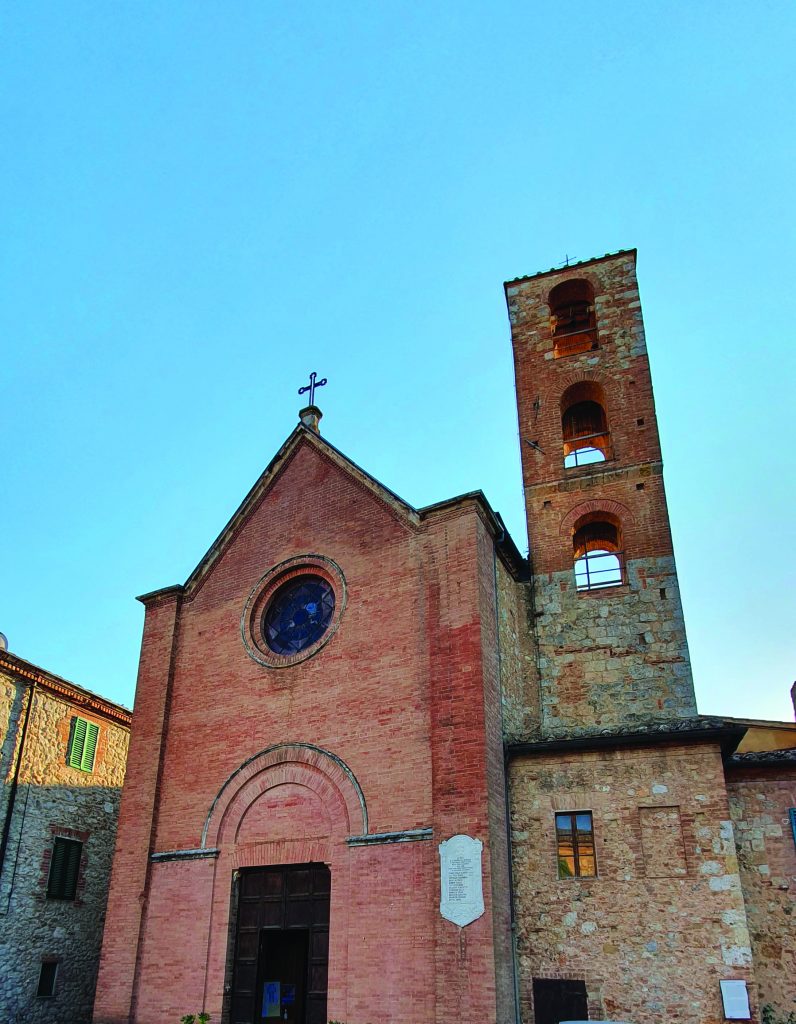
The architrave depicts a hunt for evil monsters, and observers can spot the figures of an armed knight, a man with a quiver, and an archer fighting a monster that resembles a dragon. It is hypothesised that the architrave originates from another church, presumably the nearby Parish Church of Ponte allo Spino, where, on the left side above the entrance, a large portion of the stone is missing and has been replaced with limestone. The Parish Church of St Lawrence features a rectangular belltower with a height of 20m, constructed using stone and brick and with two bells. The smaller bell is engraved with St Michael and three saints holding vases of flowers. In August 1903, one of the two bells fell; in order to protect the safety of the public, the town council decided to begin restoration work, granting the sum of 507 litre for the project. Leaving the church, immersed in the historic atmosphere of Piazza Marconi, we can travel by car or by bike to the nearby Parish Church of St John the Baptist, more commonly known as the Parish Church of Ponte allo Spino.
The Parish Church of Ponte allo Spino
As we travel along the SP 37 road, which is bordered by green landscapes that are transformed into carpets of sunflowers during summer, we will see the Parish Church of St John the Baptist (also known as the Parish Church of Ponte allo Spino) appear on the right. This is an important stop along the imperial road that connected Via Cassia to the Aurelia, starting from Porta San Marco, passing through Costalpino, Bagno a Soma, and the parish, before then continuing towards Radicondoli, Montieri, Monterotondo, and the sea. The parish church, located on the bridge over the Serpenna stream, was built by the Vallombrosian monks of Torri between the end of the 12th century and the beginning of the 13th, and although it has been remodelled over the centuries, it still retains certain characteristics that make it one of the most evocative examples of French influence, blending local creativity and art. Built using tuff and limestone, the parish church consists of three naves and has three apses on the rear side. The belltower, built before the church, is incorporated into its structure. Numerous elements and buildings surround the parish church: an arch to the right of the entrance leads to the remains of a small cloister and a building featuring double arched windows and a lancet arch door. In the 13th century a cloister and a rectory were built around the church to house the collegiate life of the clergy. From the end of the 15th century, the parish church was chosen as the country residence of the archbishops of Siena. Today, the parish church is still a venue for masses and wedding celebrations.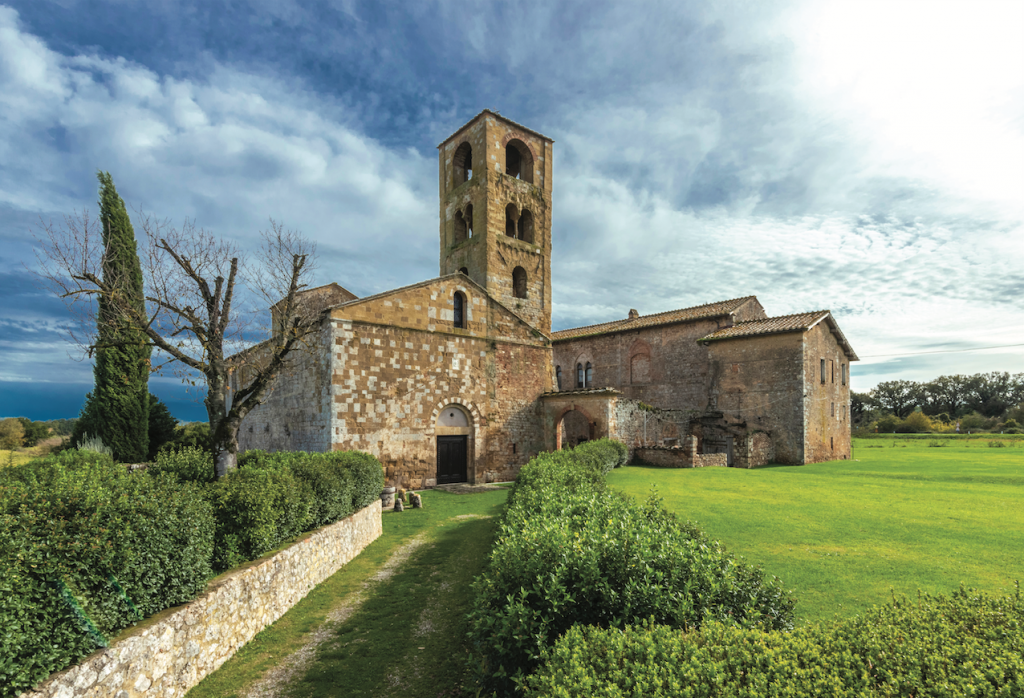
The Church of the Company of the Madonna
Once we leave the church, it is worth stopping to visit the small Church of the Company of the Madonna, just 650m away (although it is not advisable to make the journey by foot). Founded at the beginning of the 15th century as a small oratory for the lay confraternity of the Holy Conception, the church was rebuilt in 1650 at the behest of the Marquises of Chigi.
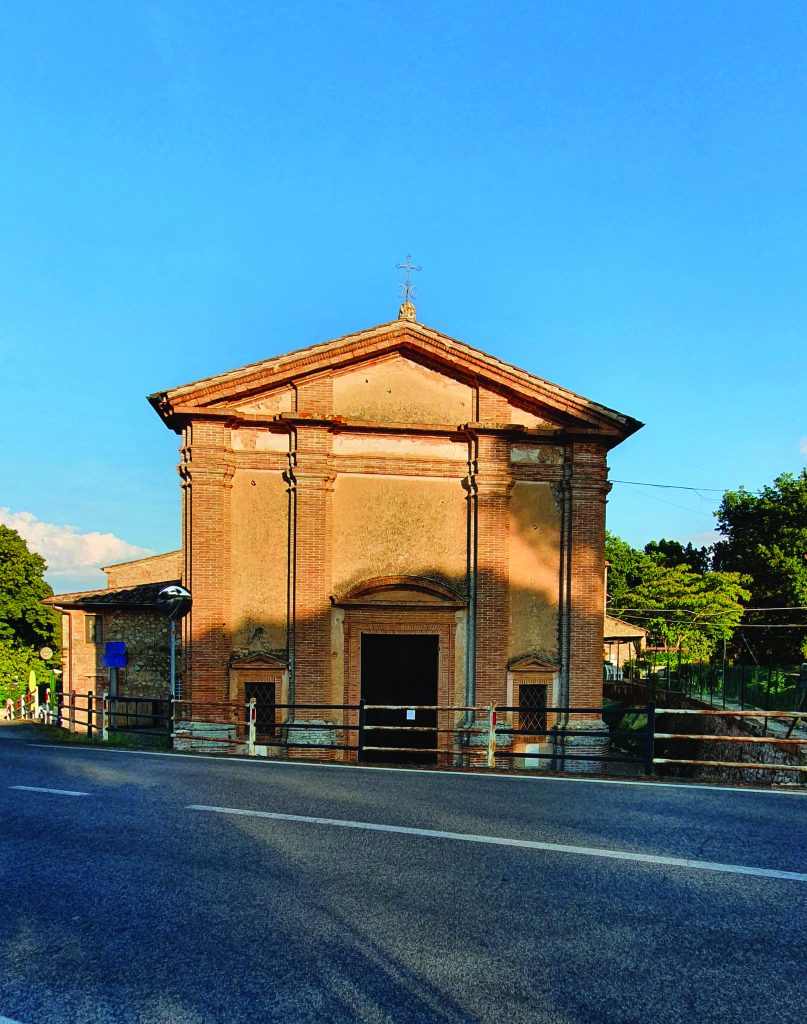
The Parish Church of St Justus in Balli
Travelling by car (the route is also suitable for bikes and motorbikes and can even be done by foot) along the Ponte allo Spino road we will arrive at the Parish Church of St Justus in Balli. Together with the parish churches of Molli and Pernina, it is considered one of the oldest testimonies of the Romanesque period in the Sienese region. The Parish Church of St Justus was built using stone, and is mentioned in documents dating back as far as 1078. In earlier times it had three naves, but towards the end of the 17th century a parish priest had one of the naves closed and transformed into a wine cellar. This church is characterised by interior circular pillars that alternate the pink of the bricks with the white of the limestone. On the outside, one of its distinguishing features is the apse, which features fragments of travertine in river pebbles and pieces of brick.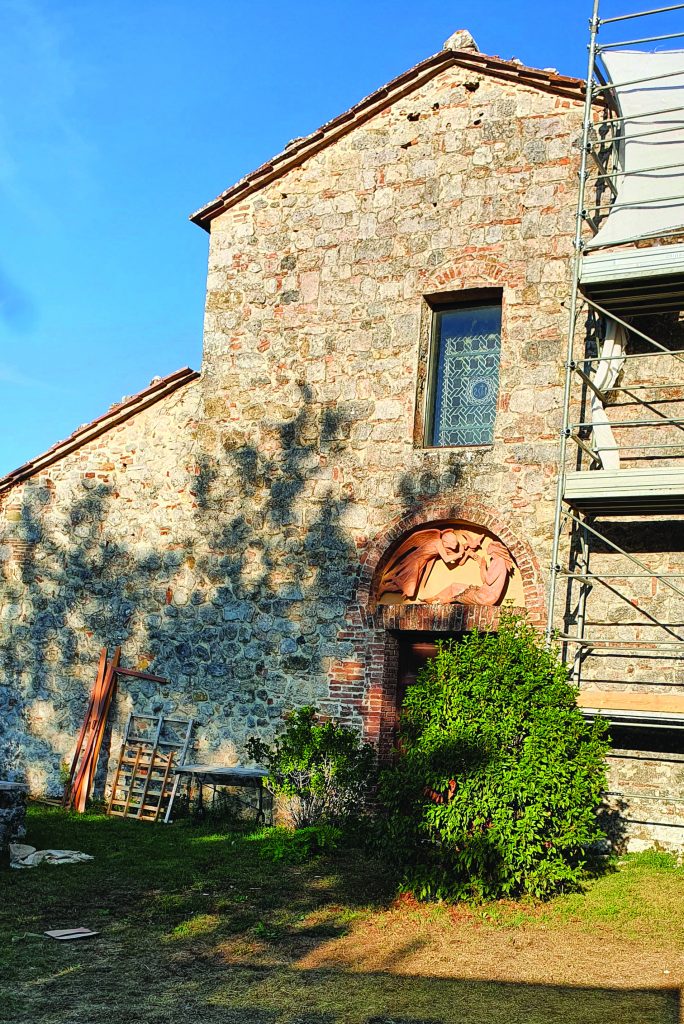
The Parish Church of St John the Baptist
Continuing along the Piscialembita road for around six kilometres, we will arrive at the Parish Church of St John the Baptist in Pernina. The church can be reached after an uphill climb along a road bordered by a wood of holly oaks, after which we turn onto a small road on the left. The earliest mention of this parish church dates back to 1078. It features three naves constructed using cavernous limestone ashlars in an ivory colour, as well as an apse and a wooden roof. Outside the church stands the belltower, with a height of 22m and built during two different periods: while the base dates back to the first half of the 12th century, the upper part was constructed at the end of the 12th century.
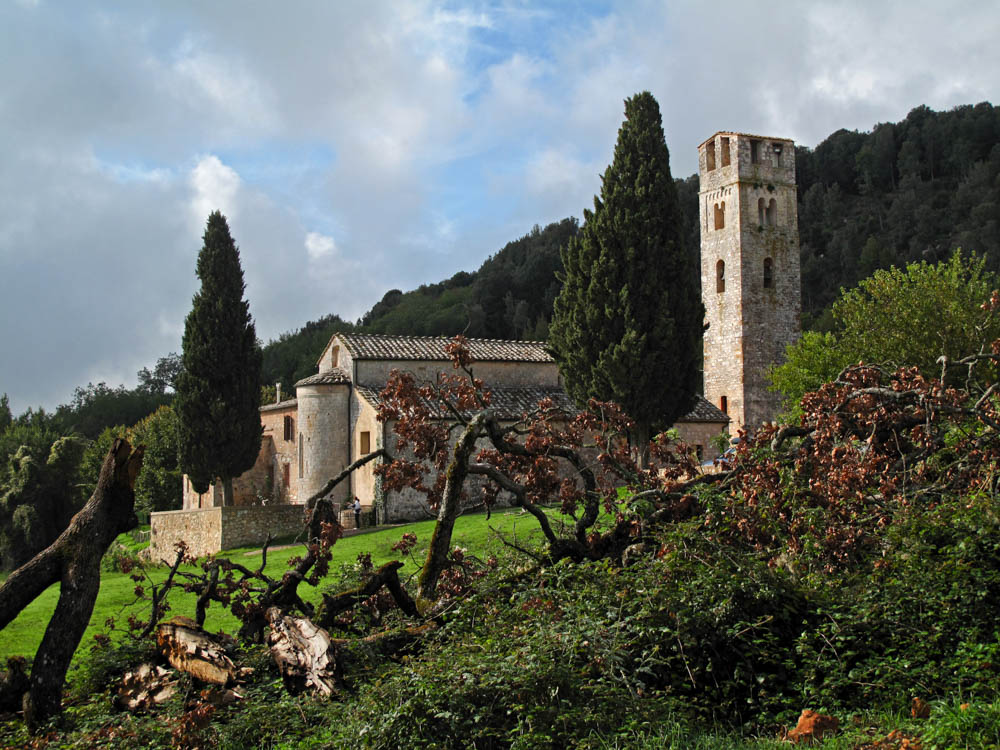
The Hermitage of Cetinale
Resuming our journey – this time on foot – we now follow the signs for the Hermitage of Cetinale. Located less than 1km away, our journey takes us deeper into the rural landscape and the silence of woods filled with beech trees and holly oaks, inviting us to meditate and find inner peace. The structure we are visiting was inhabited in ancient times by a group of hermits under the ecclesiastical authority of the Bishop of Colle Val d’Elsa, and linked to the master of Cetinale by special obligations. These obligations included holding masses, carrying out charitable work upon request, and visiting the chapel of the villa once a month on pain of dismissal. The monks dedicated their days to caring for the sick and the dying. They lived in extremely humble conditions and only received provisions from the villa when they could not manage to get by on alms. To access the hermitage, which is located on a hill, visitors ascend a staircase of over 500m, known as the Scala Santa (Holy Staircase). It consists of 200 stone steps and was often traversed by the faithful as a form of penance. It can, however, be bypassed by a small road that runs from the parish church to Pernina. Today, the chapel and hermits’ rooms cannot be visited; visitors can only admire the hermitage from outside and imagine what life was like here. The villa that stands nearby was built by Flavio Chigi to celebrate the election of his uncle Fabio Chigi as Pope, who took the name of Alexander VII (1676-1678). The hermitage was built later, in 1716, together with the Tebaide, a place of meditation and atonement. Legend tells that the holy staircase and the Tebaide were built upon the wishes of Flavius to atone for the killing of a rival in love.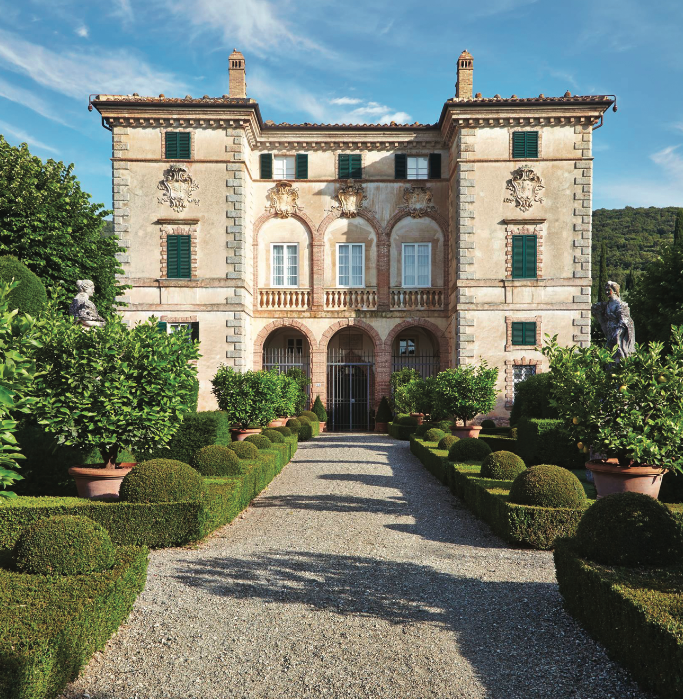
The Church of St Bartholomew
If we continue our journey and follow the Cetinale road for 3.5km, we will eventually arrive at the Church of St Bartholomew in Ancaiano. An ancient medieval church, it was badly damaged by the imperial troops during the war of Siena and rebuilt in a Renaissance style in 1660 upon the orders of Pope Alexander VII to a design by Baldassarre Peruzzi, who was born in Ancaiano in 1480. The church features a floor plan in the shape of a Latin cross and a single nave surmounted by a barrel vault with a semi-circular apse. Of its medieval furnishings, a panel showing the Madonna and Child, painted by Segna di Buonaventura, is preserved in the Civic Museum and Art Gallery of Colle Val d’Elsa.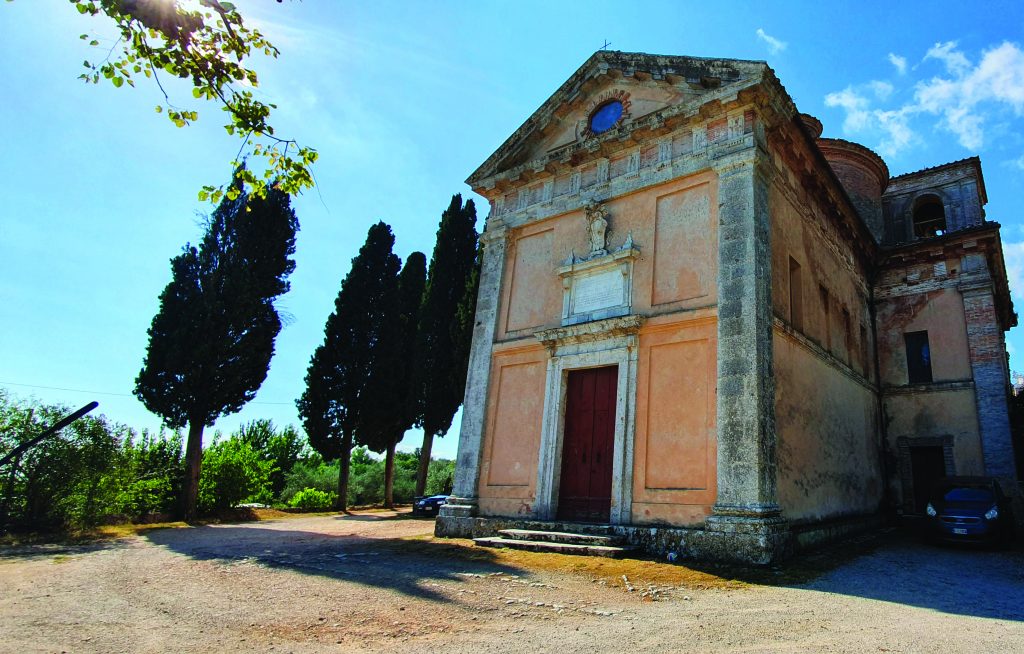
Poggiarello di Toiano
Let us continue our route from the Parish Church of Ponte allo Spino, leaving it behind and taking the Caldana road towards Poggiarello di Toiano. Here we find a medieval castle with a small chapel dedicated to St Augustine on its eastern side, which was built in 1558 by Augusto Sigismondo Chigi, probably to a design by Baldassarre Peruzzi.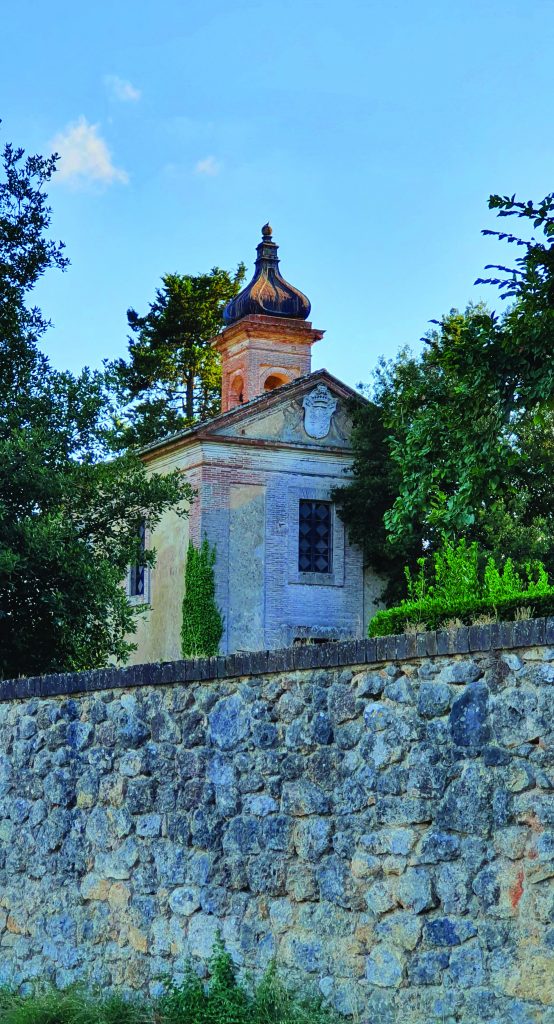
The Church of St Peter
Turning back along the road that we have so far followed, and returning towards the Parish Church of Ponte allo Spino , let us continue on the SP37 towards Siena. After a few kilometres we must turn right, following the signs for Volte Alte and continuing along the road until we reach Barontoli, where the Church of St Peter is well worth a visit. This church is a Romanesque structure dating back to 730, the year in which the Lombards founded the Abbey of St Eugene in Siena, providing it with assets and possessions that included the Church of St Peter. Today, very little remains of that original structure, which was rebuilt in 1700 with renovations taking place in the following centuries. An intriguing legend surrounds this church: in ancient times, the story tells, a Roman temple dedicated to the god Faunus stood on the site where today’s building now stands. In Christian times, this temple was dedicated instead to St Peter. Nobody knows whether the story is true or not, but now it is time for us to get back on the road and discover an exciting new location in Sovicille.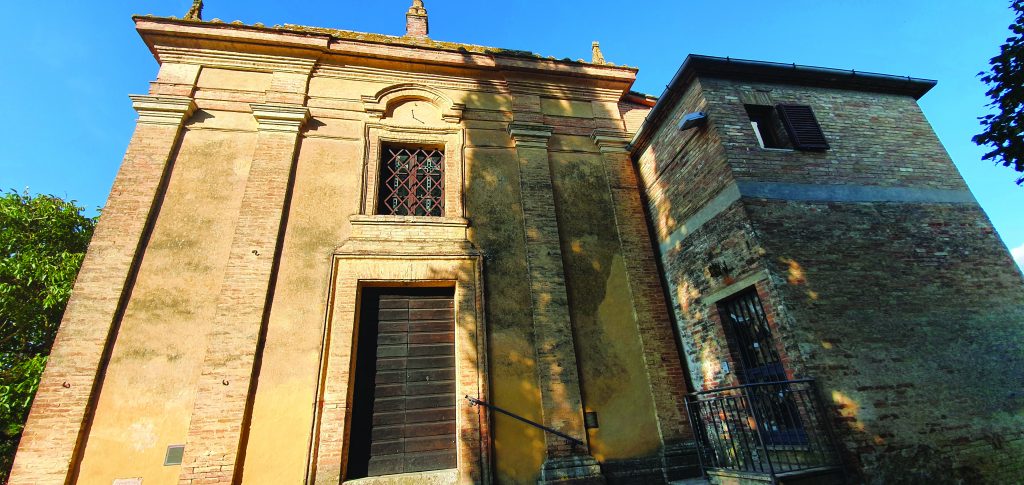
The Roman Parish Church of St John the Baptist
Continuing along the SP37 towards Rosia for 8.2km, we eventually arrive at the Romanesque Parish Church of St John the Baptist, which was considered one of the most important religious centres in medieval Siena. Situated in the heart of the town, the parish church today has a different orientation to its historic predecessor, with the current façade corresponding to the original rear part. The well preserved belltower is of particular interest, featuring single, double, triple, and four light windows in line with the typical style of Lombardy.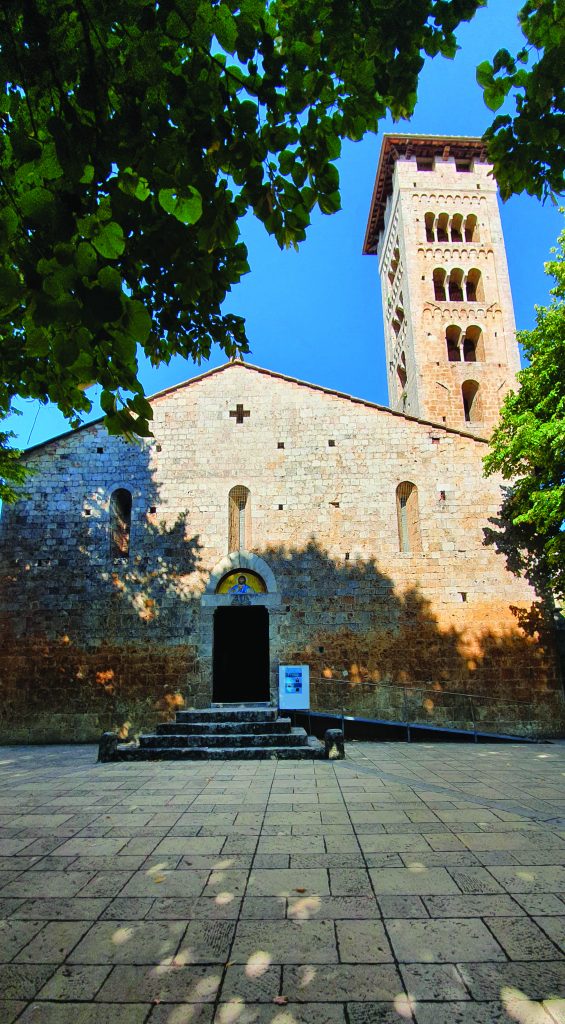
Vallombrosa Abbey
If we continue along the SP99 for 2.4km, it conveys us to one of the area’s most picturesque villages: Torri. This is a place where visitors can still immerse themselves in a medieval setting, thanks to the exceptional state of preservation of the village, which was built in 1069 around Vallombrosa Abbey. It was constructed upon the orders of Pope Alexander II, through the intercession of Beatrice di Lorena. The Abbey was highly influential in the 13th century, and was also used as a bishop’s residence. Of the original building, visitors today can still admire the church, which has been renovated in a Gothic style, and a cloister in an evocative Romanesque style.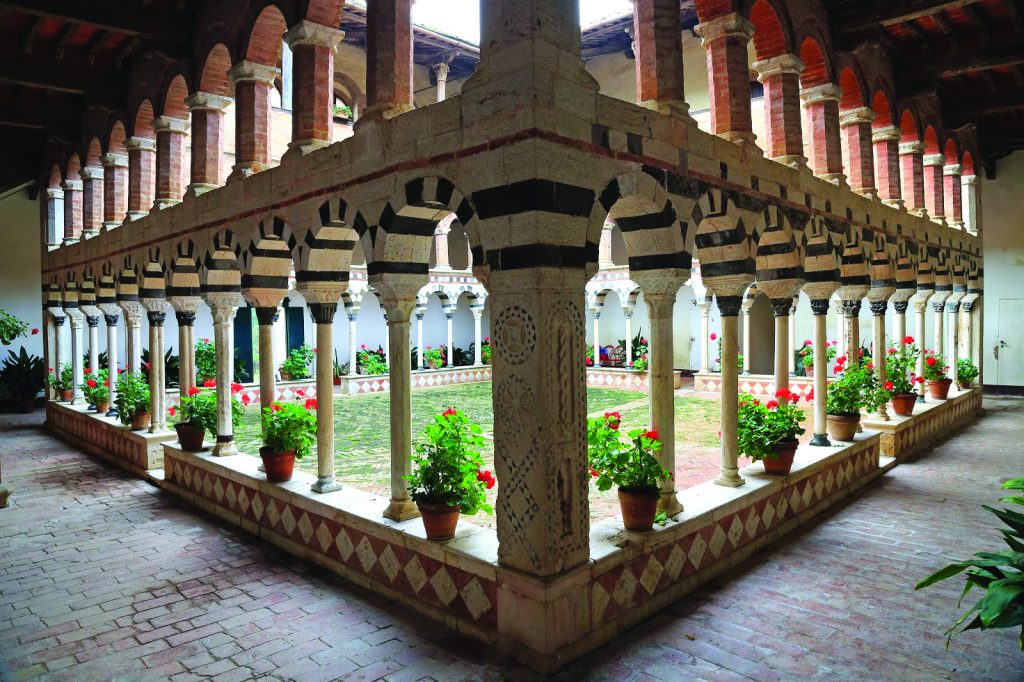
The Parish Church of Santa Mustiola
The medieval Monastery of the Holy Trinity and Santa Mustiola, better known as the Parish Church of Santa Mustiola, is a place of great interest: it is the only church in Tuscany whose Romanesque features have survived intact. It has eleven arches on each side, supported by slender columns with richly carved capitals featuring plant motifs. Inside the church, there is a high altar made of stone and a panel by Luca di Tommè depicting The Madonna and Child.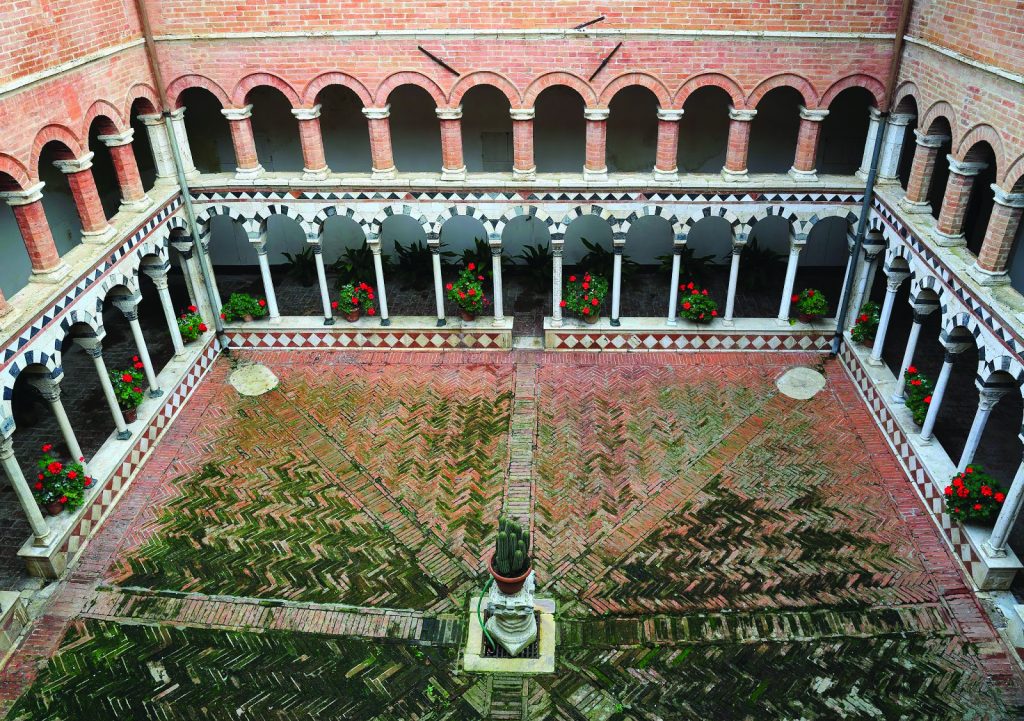
The Parish Church of Molli
Let us take to the road once more to follow the SP99, before taking the SP37, to find ourselves on Provincial Road 53 in the region of Montagnola Senese. The road crosses Via Molli and after 12.8km leads us to the Parish Church of Molli. Here, we find ourselves in front of a very simple building with a single nave and a belltower. It sits at one of the highest points in Montagnola Senese and on the division between Val di Merse and Val d’Elsa. The origins of the Parish Church of Molli are very old: the presence of the church was recorded in 1078, when it was part of the donation made by Countess Matilde di Canossa to the bishops of Volterra. Above the church there is a small cemetery, on the left of which there is a path that leads to some old abandoned marble quarries, around 100m away. Near the quarries, visitors can admire a chestnut tree that is several hundred years old, known as Il Castagnone. In fact, in ancient times, this area surrounding the parish church was home to a community dedicated to the agriculture of arable crops, vines, and chestnut trees. Our journey ends in this ancient place, where visitors can still immerse themselves in a distant past that has left indelible traces of its history in this land, where there is still plenty to discover.
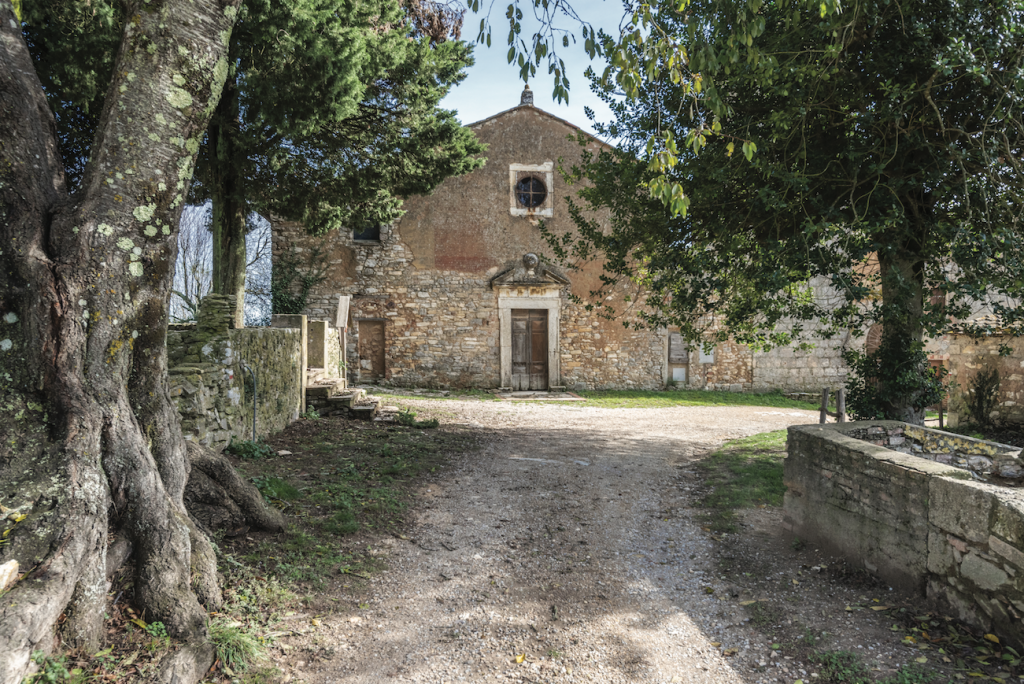
Brochure edited by Toscanalibri.it
Texts edited by Susanna Danisi
Editorial coordination:
Elisa Boniello and Laura Modafferi Photos: Primamedia, Sabrina Lauriston e Leonardo Castelli
Graphic design: Michela Bracciali
